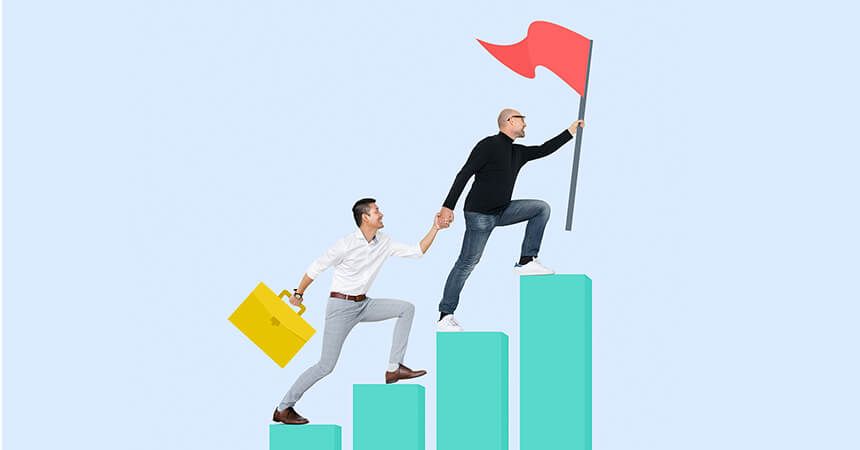Every business is out there selling products and offering services. Both online and offline, companies are doing everything they can to get to the forefront when it comes to customer recognition and retention.
Everybody wants a piece of the cake, and everybody wants it now.
The competition is fierce and there’s no time to waste. How can you stick out from the crowd both online and offline?
By understanding the basics of customer value and the customer value journey and in this blog post, we are going to talk about that.
Before we start, there’s an important question every entrepreneur has to ask themselves:
What kind of value do I provide on the market and how can I use that value to get new customers and turn them into my brand ambassadors?
The truth is that people don’t really care about your actual product. They care about how that product can improve their lives.
Knowing and taking advantage of this can help you with the other part of the question. By knowing how to use that value, you can generate new customers easily and every single time.
How? Let’s break it down.
The Value Journey
Even though you are fully aware that what’s the characteristic that can transform your customers’ lives, you also have to know that there are different levels and stages where your prospects interact with your brand and products. By understanding these stages, you can gain better insight into how you should take advantage of the value of your products
So, the customer value journey consists of the following stages:
The Aware stage
This is the first stage of your customer journey and the one where your prospect (new potential customer) first sees your brand and becomes interested in what it has to offer. Think about it as a fresh start, when somebody notices an attractive person in a room.
The Engagement stage
At this stage, the potential customer starts to research your brand and starts to engage with it. They become a part of your traffic, they check out your social channels, look up your business location and so on. Think of it as walking up to the attractive person and making an introduction.
The Subscription stage
This is the part when you “lure” in the potential prospect, by making them subscribe to your email or by making them follow you on social media. At this point, they are very well aware of your brand and looking forward to further interactions. It’s making plans to go on a first date.
The Conversion stage
This is the point where the first purchase has been made, the prospect has turned into a customer. Let’s put it this way, the first date was a success!
The Excitement stage
After scoring a customer and a subscriber, it’s your turn to keep them excited about their purchase they’ve made with different specials. It’s like going on a second and a third date, and both of you are happy with the results.
The Ascension stage
At this level, everything is going great and it’s time to introduce your customer to new products, better offers, etc. The point here is to encourage him or her to make higher purchases. It’s like being officially in a relationship, if we may use the allegory from the previous stages.
The Advocate stage
At this level, the customer advocates your product/brand/business to others, just as if the relationship was “social media official”.
The Promotion stage
At the final level, the customer is actively promoting you and bringing in new prospects who become your customers. At this point, this is love.

Now that you know the stages, here are a few tips and tactics on how to interact with your prospect at every single stage.
It’s vital for you to know how to use every single asset in your digital arsenal, so you can smoothly guide prospects through the customer value journey.
The Awareness stage
PPC – Ad campaigns can serve as “digital billboards” and are great tools for raising awareness. Scrolling through the Facebook feed and coming across an eye-catching ad visual might as well be an ideal start for a journey.
Content Marketing – Content is still king and SEO-optimized blogs still serve as a staple for lead generation and for driving traffic.
Social Media Marketing – Stunning visuals, engaging posts, great storytelling – social media is a great platform for raising awareness, so having a good marketing strategy here and being active as a brand can help spread the word about your business.
Copywriting – Copy is a crucial aspect for every platform and for every message you’re trying to send. Be informative, inviting, but never forget that your copy should be driving sales. Create structured copies, with keywords, bullet points, and short, understandable paragraphs, whenever you choose to write long-form.
The Engagement stage
Content Marketing – Create content that’s aimed for those people who regularly engage with your brand. Create product test videos, how-to blog posts, best practices posts… See what your followers want to hear/see/read and work off of that. This is value out of the box for free and can strengthen the developing bond between your brand and your audience.
Social Media Marketing – At the second stage, create polls, ask questions, ask for opinions and views. Social media lets you get creative and lets your audience express themselves with ease.
Email Marketing – Deliver weekly value to customers and potential customers. The key here is to keep providing them with value (like writing about trends, new products, and handy info) apart from focusing on only driving sales.
The Subscription stage
Content Marketing – This is a crucial point in the customer value journey since this is the point where you receive personal information and data from your prospects. With content, you can get them to subscribe multiple ways – with email marketing, you can take them to your newsletters, social media lets them see your social posts where you can recommend them the option of a newsletter subscription again. At this stage, you should aim to keep giving a reason for yourself to reach out to them and to get bits of their info.
Email Marketing – Another newsletter… But wait – go one step further. Apart from giving away valuable info in your emails, throw in a SHARE option. It’s a simple trick, but this way, your prospects can share the info they find especially handy, promoting your business without you having to do the extra leg work.
Digital Advertising – Tracking cookie policies on your website enables you to get info from your prospects and to retarget them later on with ads of your products and services, or with brand awareness in general.
Copywriting – As a general rule, your copy would have to be even a bit more inviting at this stage, helping to push sales and deepening the bond with the customer.
The Conversion Stage
Digital Advertising – Based on the type of product or service you use, you can target your subscribers with an array of different ads that will convert them into your customers. If you offer streaming or other online services that require them to use your platforms, offer them a 7-day free trial then automatically convert them into your customers after the trial has finished. On the other hand, offer a basic product or service, then, after the initial purchase, suggest further products and service packs – keep the ball rolling.
Copywriting – At this level, your copy should reflect your intentions of converting your subscriber-prospects. On your landing pages or in your newsletters, try to further encourage the purchase. Create a copy that would actually make them instantly feel and understand the benefits of using your products and services.
Email Marketing – Offer specials or discounts through your newsletters. Store credit, for instance, can be a great strategy since it encourages your prospects to make not just the initial purchase, but down the line, to stack up their credit.
The Excitement stage
Email Marketing – At this point, we assume that the customer was satisfied with your products and gained value from their purchase. As such, your emails should also focus on exciting your customers to buy more. Complimentary content and extra links in your letters may encourage them to spend more time on your site, browsing your products and ultimately, making a purchase.
Content Marketing – Basically, the same message as above. Create excitement in your content about a product or a service. Copy should align with the tone of the content – using caps, bolded words will all add to the excitement, signaling the “worthiness” of the purchase.
The Ascension stage
Email Marketing – To take the relationship into new heights, it’s a great time to offer upgrades and upsell packages. Improved, premium service packs, VIP memberships, and similar upgrades are all welcome here, and the copy in the letters should put emphasis on all the benefits coming with these upgrades.
Copywriting – As mentioned above, the copy should reinforce the benefits and the need for these upgrades.
The Advocation Stage
Social Media Marketing – At this point, you have customers who are basically fans of your brand. Testimonials, positive reviews, recommendations can all be displayed on your social channels, and they can make a huge impact on those who have yet to build trust with your brand. On the other hand, it encourages your advocates to keep believing in your brand.
Email Marketing – If you are an online store, including positive reviews for certain products or services in your newsletter can be a great way to take advantage of this stage. As with social media, the power of good reviews can be enormous, so make sure to use every piece of positive feedback you can.
Search Marketing – Optimizing your website to show product or service reviews in browsers can save a huge amount of time for people who are already looking to make a purchase. Help them cut to the chase.
The Promotion Stage
Email Marketing – At this point, your customers actively seek to promote your business. So, why not help them? Offer branded t-shirts, mugs, and other merchandise goodies to your most loyal customers.
General marketing – You can push these promotional goods through all your social media channels and include them in your content marketing.

The Omni-Channel approach and customer behavior
As you might have noticed, when pointing out the key actions regarding every stage, we referenced more than one channel. That’s right. In order to take advantage of the value of your products and to market them properly, you need to adjust to customer behavior and use all channels that can help you drive your sales.
Why?
First of all, you need to understand that people are bombarded with ads all the time everywhere, online and offline. So in order to prevent “information overdose”, it’s best to use every channel you can in a subtle fashion, with less aggressive marketing approaches but to use them strategically, drawing your prospects nearer every time. Facebook ads, subscriptions, newsletters, specials, and other marketing tools should be used in combination and in a fine blend, so the prospect won’t get overflowed with your ads, but instead has the impressions that he or she has made the conscious decision of becoming your customer and later on, brand promoter.
Now, we won’t lie, this is hard. Creating such a strategy craves years of experiment and marketplace knowledge, along with understanding sales-psychology and taking advantage of the newest available marketing tools. Automation marketing, coupled with a well-rounded strategy can help you create a fine-tuned omni-channel approach while saving you precious time and money along the way.

Are you interested in automation marketing? If yes, learn more about it here. Or, if you want to see it for yourself, let us know.
Putting it all together
As you can see, by adding value at every stage of the customer journey, you can simply increase the number of your customers, purchase frequency, and purchase amount. Creating brand promoters or ambassadors is your ultimate goal since they help you market your brand and raise awareness.
Also, you should understand that all your channels and different marketing practices should be coherent and function as a whole strategy. Every building block should be aligned at every stage since customers don’t really follow a linear path channel-wise, but tend to hop from emails to social media, to websites…
Providing value at every single stage is not an easy job, as it takes a lot of planning, fine-tuning, and experience. On the other hand, it can be really time-consuming, so deploying such technologies as automation marketing, entrepreneurs can save precious time and money, along with maximizing their efforts.
On the other hand, if you’d like to download a compiled list of pointers, click here
If you too would like to incorporate these useful tactics into your marketing strategy, along with automation, feel free to reach out to us here, so we can schedule your free consultation.



